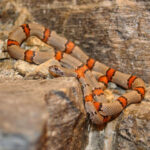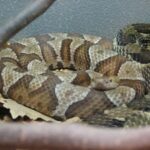Breeding mice is a fairly easy, and can be relatively cheap process. If you own snakes, or other reptiles that eat mice as a diet, it is certainly a much cheaper way of feeding. Plus, I enjoy it because it assures the environment in which the food I feed my prize is bred. I’m assured a nice healthy diet, thus a nice healthy pet.
First you will need a pair of mice. If you’re just starting, I highly recommend one male and one female. If you find that isn’t enough food, or you get the hang of breeding, feel free to add more females into the equation. As long as you’re getting babies, I do not recommend bringing in another male. Right now, we’ll focus on beginning breeding thus one male and one female. If you’ve housed your pair together for any more than 3 months and still have no results, I would try changing out one of the pair, or getting a new pair all together. Sometimes, a pair just doesn’t mate.
As far as housing goes, this depends on how into breeding you get. If you’re just seeing if it’s for you, you can simply use Rubbermaid totes (or any brand). You can make and easy top by cutting some 1 by 2s to the size you need. You want them to sit just outside the lip of the tote. Then, simply staple some screen to the bottom of your frame. Be sure your screen does not allow room for mice to crawl out. I also recommend putting something heavy on the top of the cage. A piece of wood works great. It ensures your mice can’t push the top off. This container allows your water bottle to sit on the top of the cage, on the outside. The mice will not be able to chew it, either. If you know you will be continually breeding mice, I recommend going ahead and getting an actual cage.
I just use small 10-gallon aquariums, with screen lids. I have a ramp to the top, and still keep my water bottle on the outside. I lost a lot of water bottles from them chewing when it was inside the cage. Mice do not need any specific lighting. The daily light in a house is plenty. They do need a steady schedule though. 12 hours of light and 12 of dark is ideal. However, this is not always possible. I keep my mice in the house; therefore they get approximately 9 hours of dark, and the rest light. As long as they get steady hours of dark, this shouldn’t be a concern. Remember, even flicking the light on and off will affect them. As far as bedding, I use aspen chips. It contains no oils, so it is the safest. You may also use newspaper. You can also use cedar or pine shavings. Just remember, they do contain oil and every now and then, it does affect some mice. Your mice will need a place to hide. I simply use a tissue box, and change it out when necessary. Now, the amount of cages you will need. I have a cage for every female, and a cage for my male. So, for starting breeders, with one pair of mice, you would need two cages.
I make it with minimal cages because I rotate my mice, for ease of tracking whose breeding and whose ready to drop. For beginners, I put my male and female into “his” cage. Then when I’m sure she’s pregnant, I put her into “her” cage. She remains there, until her litter is weaned. At that point I move her back with the male, for breeding. Some people keep their females pregnant. It really is not good for the female. It is very hard on their bodies. For optimal litter health, deal with one litter at a time. I almost always have a female in with my male, as I have them on different cycles. So, I always have a litter dropping. While the female is in “his” cage, my litter grows to their full potential, and then I kill and freeze them. I do this the same day I am moving her back into her cage to birth. I will show my schedule in a moment.
The diet of mice is quite simple. You can buy “mice and rat” food. That is what they need. The other products for all small animals, gerbils, hamsters, etc is not acceptable. It does not contain everything the mice will need. You may also supplement some dog food, for protein. Remember, this is not their diet! It is a supplement. They always need fresh water for drinking. Be sure to change it out every couple of days, even if it’s not empty. They will need a water bottle for drinking. You may use a food dish, but it’s not necessary. If you do, be sure it’s something they won’t chew.
It really does not take long for your mice to breed or become impregnated, once you get a good breeding pair going. Gestation is usually 19-21 days. You should wean your mice by 21 days. You really don’t have to do anything for this, it will happen. At the 21st day, I pull my female out of the cage, and put her back in the male’s cage. A litter of pups is around 9-11 babies. This can and does vary. You can easily have a litter up to 20! My average litter size, personally, is 13 pups. To keep my cage from over crowding, I do kill off some of my pups before they are full-grown. While I’m waiting for my litter to raise, I take out the males and feed them as “snacks” to my snake. If you leave all the litter males in the cage together, they will fight and kill each other.
Now onto my breeding schedule. To make this as efficient as possible, we will call my female cage, cage “A”. My male cage will be, cage “B”. I start with both mice in cage B. When I’m sure my female is pregnant (she gets noticeably fat, and right before she drops, she get s a lumpy belly), I move her to cage A. Let’s say she births the litter on the 1st of the month. I leave it just like that until the 21st. At this point, I put the female into cage B. Over the next 2 weeks I feed off all the males (I don’t freeze them, being I only need full grown mice, but if you do-go ahead!). On the 12th of that month (sticking to the same schedule), I kill off and freeze my remaining mice from the litter. I clean the cage, and put my female back into cage A. This starts the process all over again. Now, say I was using 2 females. At this point (on the 12th of that month), I would put my other female in with the male, into cage B. This would allow breeding, and keep the two females on different schedules.
That is it. It really is a simply process. After the first couple of litters, you get the hang of it, and will develop a schedule.





